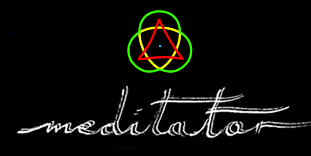FROM MEDITATOR.ORG
'Posture'
Meditation is
as old as humans maybe even older.
It enables one to commune with all that one is, was and will be.
Such
a claim may defy logic but then again meditation transcends mind
and
defies logic.
In meditation the mind rests within its origin, the primordial
and
uncreated. Meditation is indescribable but could be compared to
a
journey to the source of one’s being. It enables one to become
more
aware.
One may give to
oneself a command such as: “be silent and know who
you are”.
Countless meditation techniques use a ‘meditation object’ to
focus
on. These could be: a phrase, a mantra, a gesture or movement,
a
symbol, an external object, the breath, the heartbeat, space,
void
...to list but a few such objects. Such devices help to focus
the
attention. This is the initial stage to any meditation:
gathering
one’s attention.
However the real object of awareness is awareness itself and
when
this mirroring happens one simply ceases to be all that one
usually
believes that one is. If that condition is maintained with
practice
over time Knowledge arises.
There are many
pitfalls on this path and so one should try to check
one’s practice regularly with an experienced meditator or
teacher. He
or she will check that your body posture is good and that you
are
following the instructions of your
meditation.
Meditation has
been taught within the context of living oral
traditions responsible for passing on Knowledge from one
generation
to the next. This oral aspect of the meditation tradition can
never
be imparted to someone by some lifeless book or object no matter
how
good or beautiful that is.
Having said this there is nothing
wrong with trying to go it alone until a
teacher appears. Afterall who taught the
Buddha?
Meditation is a
practice which need not be allied to any particular
religious tradition, although many choose to practice it within
some
religious framework.
Meditation is not thinking.
It is a natural activity which happens when we ‘switch
off’
our mundane conditioned mode of operation and may find
ourselves
simply gazing at the flames of a fire or listening to the
crashing of
waves on the sea shore, or sense the rustling of the leaves in
the
trees, or feel the rising and fall of our
breathing.
With practice
one succeeds in being in the present instead of
daydreaming one self in the past or the future. Meditating is
so
natural that one may wonder how one ever forgot how to do it in
the
first place.
Simple does not
mean simplistic. Rather than trying to give quick
answers to everything, as our habitual mind likes to do, at the
root
of the desire to meditate there is the kernel of a desire to
Know
more. It begins to grow when one takes an earnest and honest
step
towards confronting the Unknown within oneself by doing
one's
meditation practice.
-Copyright Byron Zeliotis-
|
